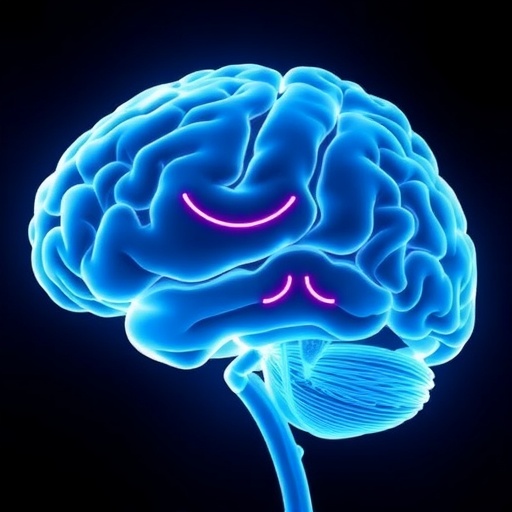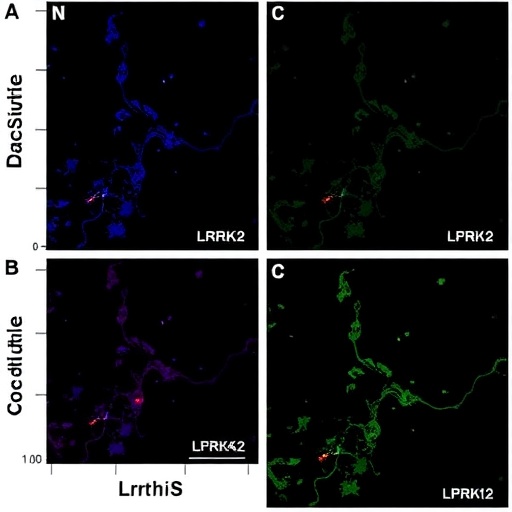
In recent years, deep brain stimulation (DBS) of the subthalamic nucleus (STN) has solidified its position as a transformative therapy for the motor symptoms of Parkinsonâs disease (PD). While the efficacy of STN-DBS in mitigating tremors, rigidity, and bradykinesia is well documented, the cognitive outcomes following this intervention remain complex and less predictable. A new study published in npj Parkinsonâs Disease by Kübler-Weller and colleagues offers groundbreaking insights into predicting cognitive trajectories in PD patients undergoing STN-DBS. This advancement carries profound implications not only for clinical decision-making but also for our broader understanding of the neurobiological interplay between motor and cognitive circuits affected by PD.
Parkinsonâs disease, characterized primarily by dopaminergic neuron degeneration in the substantia nigra, manifests with a constellation of motor and non-motor symptoms. Despite pharmacological therapies such as levodopa dramatically improving motor function, these options often lose efficacy over time and are accompanied by significant side effects. DBS targeting the subthalamic nucleus has emerged as a highly effective surgical treatment, providing sustained motor improvement by modulating dysfunctional basal ganglia circuitry. However, concerns have been raised about the potential adverse effects on cognition, including deficits in executive function, verbal fluency, and memory, in a subset of patients after STN-DBS.
The study by Kübler-Weller et al. represents a major advance toward demystifying this heterogeneity in cognitive outcomes. Using a large cohort of PD patients scheduled for STN-DBS, the researchers implemented a comprehensive battery of neuropsychological assessments prior to surgery and followed cognitive performance longitudinally. Their methodological rigor involved integrating clinical data with advanced statistical models to identify predictors of cognitive decline or stability post-DBS. This approach demonstrates an important shift from the traditional reactive clinical approach toward a more nuanced, predictive framework that could ultimately guide personalized therapy.
One of the core findings was the identification of specific baseline cognitive profiles and neuroanatomical markers that stratified patients into distinct risk categories for post-operative cognitive decline. Patients who displayed subtle impairments in executive function and verbal fluency before surgery were more vulnerable to further cognitive deterioration after DBS. Moreover, volumetric MRI imaging highlighted that reduced baseline gray matter volume in frontal and temporal regions correlated strongly with negative cognitive outcomes. These data underscore the critical need to consider pre-surgical cognitive and structural brain measures when counseling patients about potential risks and benefits.
The study also illuminates the mechanistic underpinnings of how STN-DBS can influence cognitive pathways. The subthalamic nucleus is a pivotal node within the basal ganglia-thalamocortical circuits, implicated in both motor control and cognitive processing. Electrical stimulation intended to modulate motor circuits can inadvertently perturb the delicate balance within associative and limbic loops, thereby affecting cognitive domains such as working memory and inhibitory control. Kübler-Weller and colleagues propose that variability in the functional anatomy of these circuits among patients accounts for differential cognitive responses to DBS, a hypothesis supported by their neuroimaging correlations.
Importantly, the research team employed machine learning algorithms to build predictive models integrating demographic, clinical, cognitive, and neuroimaging variables. Their models demonstrated high accuracy in forecasting individual cognitive trajectories after STN-DBS. This innovation paves the way for clinical decision support tools that can refine patient selection, optimize surgical targeting, and tailor post-operative management strategies. Such precision medicine approaches have the potential to maximize therapeutic gains while minimizing adverse cognitive sequelae, a balancing act that has long challenged neurologists and neurosurgeons.
The broader implications of this work extend into the evolving landscape of neurodegenerative disease treatment. As DBS indications expand and new neuromodulation technologies emerge, the emphasis on cognitive safety and outcomes must be integrated into every stage of therapeutic development. Furthermore, the multidisciplinary methodology combining neuropsychology, neuroimaging, and computational modeling exemplifies how collaborative science can unravel complex brain-behavior relationships in human disease. This paradigm may also inspire analogous predictive efforts in other conditions treated with neuromodulatory interventions.
Clinicians stand to benefit considerably from these insights. Traditionally, patient selection for STN-DBS relied heavily on motor symptom severity and responsiveness to medication, with less attention to cognitive risk stratification. The ability to predict cognitive outcomes with greater fidelity enables more informed consent discussions, allowing patients and families to weigh potential trade-offs realistically. Moreover, it encourages longitudinal cognitive monitoring and early interventions such as cognitive rehabilitation or medication adjustments for high-risk individuals, thereby enhancing overall care quality.
From the patient perspective, understanding the nuances of DBS outcomes is critical. Hope for motor improvement may sometimes overshadow concerns about cognition until post-operative adverse effects manifest. Offering a more transparent and personalized prognosis fosters realistic expectations and may reduce anxiety or dissatisfaction following surgery. Additionally, patients can participate more actively in shared decision-making together with their multidisciplinary care teams when equipped with individualized risk assessments derived from studies like this.
The technological advancements that underpin this study also merit attention. High-resolution magnetic resonance imaging protocols and sophisticated image analysis pipelines allow for precise quantification of brain structure alterations. Coupled with neuropsychological data and modern statistical learning techniques, these tools enable a level of predictive granularity previously unattainable in clinical neuroscience. The successful application of these technologies signals the maturation of a new era where âbig dataâ and AI intersect with neurology to improve patient outcomes substantively.
There remain, however, unanswered questions and avenues for further research. For instance, while the focus on subthalamic DBS is justified by its widespread use, other DBS targets such as the globus pallidus interna (GPi) may have different cognitive profiles post-implantation. Comparative studies are needed to delineate these differences and refine decision algorithms further. Similarly, the influence of stimulation parameters, electrode placement precision, and neuroplastic responses over time warrants deeper exploration to optimize cognitive as well as motor benefits.
Moreover, the potential for neuroprotective strategies or adjunct therapies to mitigate cognitive decline related to DBS should be a research priority. Pharmacological agents targeting neuroinflammation, synaptic plasticity, or neurotransmitter modulation might enhance recovery or resilience of cognitive circuits after surgical intervention. Identifying biomarkers that signal impending cognitive deterioration before clinical symptoms emerge could facilitate earlier therapeutic actions and improve long-term quality of life for PD patients.
The social and ethical dimensions of predictive neuroscience as demonstrated by Kübler-Weller et al.âs work also deserve thoughtful consideration. Predicting cognitive decline carries emotional weight and raises issues related to patient autonomy, privacy, and psychological impact. Clinicians must balance transparent communication of risks with supportive counseling and respect for individual values and preferences. Furthermore, as predictive models are integrated into routine care, continuous validation and updates will be essential to maintain accuracy and fairness across diverse populations.
In conclusion, the study by Kübler-Weller and colleagues represents a seminal contribution to the field of movement disorders and neuromodulation. By elucidating predictors of cognitive change following subthalamic deep brain stimulation in Parkinsonâs disease, this research advances both scientific understanding and clinical practice. It emboldens a shift toward personalized, data-driven management strategies that optimize therapeutic benefits while safeguarding cognitive health. As the population affected by PD grows, innovations such as these will be indispensable for improving patient outcomes and quality of life.
The integration of neuropsychological profiling, structural imaging, and machine learning heralds a promising future where deep brain stimulation is not only a tool for motor recovery but also a triumph of precision neurology. Future research building on these findings promises to refine patient care even further, offering hope for more predictable and favorable cognitive outcomes after DBS. Ultimately, this work reaffirms the potential of interdisciplinary, technology-driven approaches to solve some of the most challenging clinical dilemmas in neurodegenerative diseases.
Subject of Research: Predicting cognitive outcomes in Parkinsonâs disease patients following subthalamic nucleus deep brain stimulation.
Article Title: Predicting cognition after subthalamic Deep Brain Stimulation in Parkinsonâs Disease.
Article References:
Kübler-Weller, D., Stuke, H., Astalosch, M. et al. Predicting cognition after subthalamic Deep Brain Stimulation in Parkinsonâs Disease. npj Parkinsons Dis. 11, 265 (2025). https://doi.org/10.1038/s41531-025-01128-3
Image Credits: AI Generated
Tags: clinical decision-making in Parkinson’s therapydeep brain stimulation cognitive outcomesexecutive function after DBSlong-term outcomes of STN-DBSmemory deficits post-DBSmotor symptoms of Parkinson’sneurobiological effects of DBSParkinson’s cognitive trajectoriesParkinson’s disease research advancementsParkinsonâs disease treatmentsubthalamic nucleus DBSverbal fluency in Parkinson’s patients




